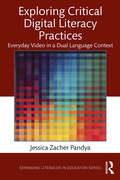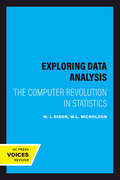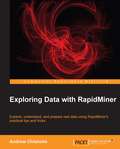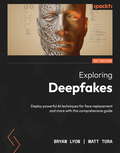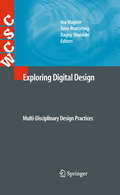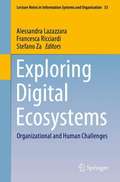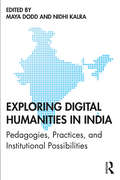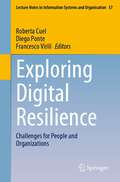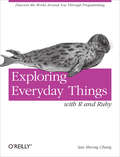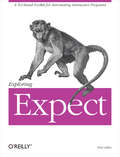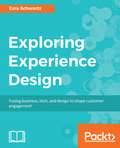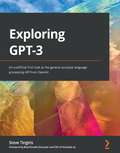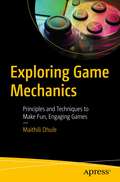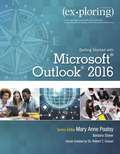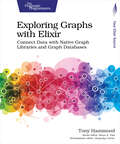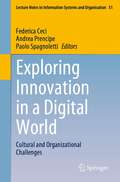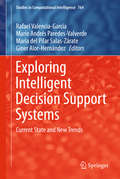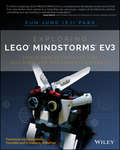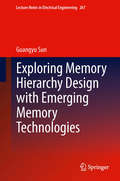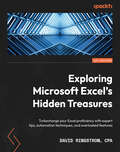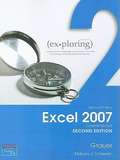- Table View
- List View
Exploring Critical Digital Literacy Practices: Everyday Video in a Dual Language Context (Expanding Literacies in Education)
by Jessica Zacher PandyaIn this book, Jessica Zacher Pandya examines the everyday videomaking practices of students in a dual language, under-resourced school in order to explore the ways children interrogate their worlds, the kinds of identities they craft, and the language and literacy learning practices that emerge from digital video production. Focusing on vulnerable populations who are often left out of innovative in- and out-of-school digital media projects—including English language learners, immigrants, and children with special needs—this book offers an expanded understanding of children’s critical digital literacy practices, and shows how videomaking in the regular curriculum affords opportunities for redistributive social justice. Weaving together pedagogical, methodological, social, and political concerns into her examination of a real-world context, Pandya offers a practical and informative analysis of making videos in schools; examines the impact of videomaking on students’ language use and agency; and adds significantly to current theorizations of digital and new literacies.
Exploring Data Analysis: The Computer Revolution in Statistics
by W. J. Dixon W. L. Nicholson xxx National Bureau of StandardsThis title is part of UC Press's Voices Revived program, which commemorates University of California Press’s mission to seek out and cultivate the brightest minds and give them voice, reach, and impact. Drawing on a backlist dating to 1893, Voices Revived makes high-quality, peer-reviewed scholarship accessible once again using print-on-demand technology. This title was originally published in 1974.This title is part of UC Press's Voices Revived program, which commemorates University of California Press’s mission to seek out and cultivate the brightest minds and give them voice, reach, and impact. Drawing on a backlist dating to 1893, Voices Revived</DIV
Exploring Data with RapidMiner
by Andrew ChisholmA step-by-step tutorial style using examples so that users of different levels will benefit from the facilities offered by RapidMiner.If you are a computer scientist or an engineer who has real data from which you want to extract value, this book is ideal for you. You will need to have at least a basic awareness of data mining techniques and some exposure to RapidMiner.
Exploring Deepfakes: Deploy powerful AI techniques for face replacement and more with this comprehensive guide
by Bryan Lyon Matt ToraMaster the innovative world of deepfakes and generative AI for face replacement with this full-color guidePurchase of the print or Kindle book includes a free PDF eBookKey FeaturesUnderstand what deepfakes are, their history, and how to use the technology ethicallyGet well-versed with the workflow and processes involved to create your own deepfakesLearn how to apply the lessons and techniques of deepfakes to your own problemsBook DescriptionApplying Deepfakes will allow you to tackle a wide range of scenarios creatively.Learning from experienced authors will help you to intuitively understand what is going on inside the model. You'll learn what deepfakes are and what makes them different from other machine learning techniques, and understand the entire process from beginning to end, from finding faces to preparing them, training the model, and performing the final swap.We'll discuss various uses for face replacement before we begin building our own pipeline. Spending some extra time thinking about how you collect your input data can make a huge difference to the quality of the final video. We look at the importance of this data and guide you with simple concepts to understand what your data needs to really be successful.No discussion of deepfakes can avoid discussing the controversial, unethical uses for which the technology initially became known. We'll go over some potential issues, and talk about the value that deepfakes can bring to a variety of educational and artistic use cases, from video game avatars to filmmaking.By the end of the book, you'll understand what deepfakes are, how they work at a fundamental level, and how to apply those techniques to your own needs.What you will learnGain a clear understanding of deepfakes and their creationUnderstand the risks of deepfakes and how to mitigate themCollect efficient data to create successful deepfakesGet familiar with the deepfakes workflow and its stepsExplore the application of deepfakes methods to your own generative needsImprove results by augmenting data and avoiding overtrainingExamine the future of deepfakes and other generative AIsUse generative AIs to increase video content resolutionWho this book is forThis book is for AI developers, data scientists, and anyone looking to learn more about deepfakes or techniques and technologies from Deepfakes to help them generate new image data. Working knowledge of Python programming language and basic familiarity with OpenCV, Pillow, Pytorch, or Tensorflow is recommended to get the most out of the book.
Exploring Digital Design
by Dagny Stuedahl Tone Bratteteig Ina WagnerExploring Digital Design takes a multi-disciplinary look at digital design research where digital design is embedded in a larger socio-cultural context. Working from socio-technical research areas such as Participatory Design (PD), Computer Supported Cooperative Work (CSCW) and Human-Computer Interaction (HCI), the book explores how humanities offer new insights into digital design, and discusses a variety of digital design research practices, methods, and theoretical approaches spanning established disciplinary borders. The aim of the book is to explore the diversity of contemporary digital design practices in which commonly shared aspects are interpreted and integrated into different disciplinary and interdisciplinary conversations. It is the conversations and explorations with humanities that further distinguish this book within digital design research. Illustrated with real examples from digital design research practices from a variety of research projects and from a broad range of contexts Exploring Digital Design offers a basis for understanding the disciplinary roots as well as the interdisciplinary dialogues in digital design research, providing theoretical, empirical, and methodological sources for understanding digital design research. The first half of the book Exploring Digital Design is authored as a multi-disciplinary approach to digital design research, and represents novel perspectives and analyses in this research. The contributors are Gunnar Liestøl, Andrew Morrison and Christina Mörtberg in addition to the editors. Although primarily written for researchers and graduate students, digital design practioners will also find the book useful. Overall, Exploring Digital Design provides an excellent introduction to, and resource for, research into digital design.
Exploring Digital Ecosystems: Organizational and Human Challenges (Lecture Notes in Information Systems and Organisation #33)
by Francesca Ricciardi Stefano Za Alessandra LazazzaraThe recent surge of interest in digital ecosystems is not only transforming the business landscape, but also poses several human and organizational challenges. Due to the pervasive effects of the transformation on firms and societies alike, both scholars and practitioners are interested in understanding the key mechanisms behind digital ecosystems, their emergence and evolution. In order to disentangle such factors, this book presents a collection of research papers focusing on the relationship between technologies (e.g. digital platforms, AI, infrastructure) and behaviours (e.g. digital learning, knowledge sharing, decision-making). Moreover, it provides critical insights into how digital ecosystems can shape value creation and benefit various stakeholders. The plurality of perspectives offered makes the book particularly relevant for users, companies, scientists and governments. The content is based on a selection of the best papers – original double-blind peer-reviewed contributions – presented at the annual conference of the Italian chapter of the AIS, which took place in Pavia, Italy in October 2018.
Exploring Digital Humanities in India: Pedagogies, Practices, and Institutional Possibilities
by Nidhi Kalra Maya DoddThis book explores the emergence of digital humanities in the Indian context. It looks at how online and digital resources have transformed classroom and research practices. It examines some fundamental questions: What is digital humanities? Who is a digital humanist? What is its place in the Indian context? The chapters in the volume: • study the varied practices and pedagogies involved in incorporating the ‘digital’ into traditional classrooms; • showcase how researchers across disciplinary lines are expanding their scope of research, by adding a ‘digital’ component to update their curriculum to contemporary times; • highlight how this has also created opportunities for researchers to push the boundaries of their pedagogy and encouraged students to create ‘live projects’ with the aid of digital platforms; and • track changes in the language of research, documentation, archiving and reproduction as new conversations are opening up across Indian languages. A major intervention in the social sciences and humanities, this book will be of great interest to scholars and researchers of media studies, especially new and digital media, education, South Asian studies and cultural studies.
Exploring Digital Resilience: Challenges for People and Organizations (Lecture Notes in Information Systems and Organisation #57)
by Roberta Cuel Francesco Virili Diego PonteThis book explores multidimensional issues concerning digital resilience and analyzes how people and organizations maintain, enhance and protect value stemming from digital technologies. Society is now heading for a future in which organizations and people will increasingly depend on digital technologies, yet to date many are still unaware of the scale and risks associated with the digital transformation. As a result, there is an urgent need for digital resilience to drive a fundamental shift in the way people and organizations understand digital technologies, risks and opportunities.The book gathers a selection of the best papers presented at the annual conference of the Italian chapter of AIS, which took place in Trento, Italy, in October 2021. The diverse range of views put forward by the authors makes it particularly relevant for scholars and practitioners interested in organization, and for all of us living in the digital transformation era.
Exploring Everyday Things with R and Ruby: Learning About Everyday Things
by Sau Sheong ChangIf you’re curious about how things work, this fun and intriguing guide will help you find real answers to everyday problems. By using fundamental math and doing simple programming with the Ruby and R languages, you’ll learn how to model a problem and work toward a solution.All you need is a basic understanding of programming. After a quick introduction to Ruby and R, you’ll explore a wide range of questions by learning how to assemble, process, simulate, and analyze the available data. You’ll learn to see everyday things in a different perspective through simple programs and common sense logic. Once you finish this book, you can begin your own journey of exploration and discovery.Here are some of the questions you’ll explore:Determine how many restroom stalls can accommodate an office with 70 employeesMine your email to understand your particular emailing habitsUse simple audio and video recording devices to calculate your heart rateCreate an artificial society—and analyze its behavioral patterns to learn how specific factors affect our real society
Exploring Expect: A Tcl-based Toolkit for Automating Interactive Programs
by Don LibesExpect is quickly becoming a part of every UNIX user's toolbox. It allows you to automate Telnet, FTP, passwd, rlogin, and hundreds of other applications that normally require human interaction. Using Expect to automate these applications will allow you to speed up tasks and, in many cases, solve new problems that you never would have even considered before.For example, you can use Expect to test interactive programs with no changes to their interfaces. Or wrap interactive programs with Motif-like front-ends to control applications by buttons, scrollbars, and other graphic elements with no recompilation of the original programs. You don't even need the source code! Expect works with remote applications, too. Use it to tie together Internet applications including Telnet, Archie, FTP, Gopher, and Mosaic.Don Libes is the creator of Expect as well as the author of this book. In Exploring Expect, he provides a comprehensive tutorial on all of Expect's features, allowing you to put it immediately to work on your problems. In a down-to-earth and humorous style, he provides numerous examples of challenging real-world applications and how they can be automated using Expect to save you time and money.Expect is the first of a new breed of programs based on Tcl, the Tool Command Language that is rocking the computer science community. This book provides an introduction to Tcl and describes how Expect applies Tcl's power to the new field of interaction automation. Whether your interest is in Expect or interaction automation or you simply want to learn about Tcl and see how it has been used in real software, you will find Exploring Expect a treasure trove of easy-to-understand and valuable information.
Exploring Experience Design
by Ezra SchwartzLearn how to unify Customer Experience, User Experience and more to shape lasting customer engagement in a world of rapid change. About This Book • An introductory guide to Experience Design that will help you break into XD as a career by gaining A strong foundational knowledge • Get acquainted with the various phases of a typical Experience Design workflow • Work through the key process and techniques in XD, supported by most of the common use cases Who This Book Is For This book is for designers who wish to enter the field of UX Design, especially Programmers, Content Strategists, and Organizations keen to understand the core concepts of UX Design. What You Will Learn • Understand why Experience Design (XD) is at the forefront of business priorities, as organizations race to innovate products and services in order to compete for customers in a global economy driven by technology and change • Get motivated by the numerous professional opportunities that XD opens up for practitioners in wide-ranging domains, and by the stories of real XD practitioners • Understand what experience is, how experiences are designed, and why they are effective • Gain knowledge of user-centered design principles, methodologies, and best practices that will improve your product (digital or physical) • Get to know your X's and D's—understand the differences between XD and UX, CX, IxD, IA, SD, VD, PD, and other design practices In Detail We live in an experience economy in which interaction with products is valued more than owning them. Products are expected to engage and delight in order to form the emotional bonds that forge long-term customer loyalty: Products need to anticipate our needs and perform tasks for us: refrigerators order food, homes monitor energy, and cars drive autonomously; they track our vitals, sleep, location, finances, interactions, and content use; recognize our biometric signatures, chat with us, understand and motivate us. Beautiful and easy to use, products have to be fully customizable to match our personal preferences. Accomplishing these feats is easier said than done, but a solution has emerged in the form of Experience design (XD), the unifying approach to fusing business, technology and design around a user-centered philosophy. This book explores key dimensions of XD: Close collaboration among interdisciplinary teams, rapid iteration and ongoing user validation. We cover the processes, methodologies, tools, techniques and best-practices practitioners use throughout the entire product development life-cycle, as ideas are transformed to into positive experiences which lead to perpetual customer engagement and brand loyalty. Style and approach An easy-to-understand guide, filled with real-world use cases on process, design, and techniques, helping you build a strong foundation in Experience Design.
Exploring GPT-3: An unofficial first look at the general-purpose language processing API from OpenAI
by Steve Tingiris Bret KinsellaGet started with GPT-3 and the OpenAI API for natural language processing using JavaScript and PythonKey FeaturesUnderstand the power of potential GPT-3 language models and the risks involvedExplore core GPT-3 use cases such as text generation, classification, and semantic search using engaging examplesPlan and prepare a GPT-3 application for the OpenAI review process required for publishing a live applicationBook DescriptionGenerative Pre-trained Transformer 3 (GPT-3) is a highly advanced language model from OpenAI that can generate written text that is virtually indistinguishable from text written by humans. Whether you have a technical or non-technical background, this book will help you understand and start working with GPT-3 and the OpenAI API. If you want to get hands-on with leveraging artificial intelligence for natural language processing (NLP) tasks, this easy-to-follow book will help you get started. Beginning with a high-level introduction to NLP and GPT-3, the book takes you through practical examples that show how to leverage the OpenAI API and GPT-3 for text generation, classification, and semantic search. You'll explore the capabilities of the OpenAI API and GPT-3 and find out which NLP use cases GPT-3 is best suited for. You'll also learn how to use the API and optimize requests for the best possible results. With examples focusing on the OpenAI Playground and easy-to-follow JavaScript and Python code samples, the book illustrates the possible applications of GPT-3 in production. By the end of this book, you'll understand the best use cases for GPT-3 and how to integrate the OpenAI API in your applications for a wide array of NLP tasks.What you will learnUnderstand what GPT-3 is and how it can be used for various NLP tasksGet a high-level introduction to GPT-3 and the OpenAI APIImplement JavaScript and Python code examples that call the OpenAI APIStructure GPT-3 prompts and options to get the best possible resultsSelect the right GPT-3 engine or model to optimize for speed and cost-efficiencyFind out which use cases would not be suitable for GPT-3Create a GPT-3-powered knowledge base application that follows OpenAI guidelinesWho this book is forExploring GPT-3 is for anyone interested in natural language processing or learning GPT-3 with or without a technical background. Developers, product managers, entrepreneurs, and hobbyists looking to get to grips with NLP, AI, and GPT-3 will find this book useful. Basic computer skills are all you need to get the most out of this book.
Exploring Game Mechanics: Principles and Techniques to Make Fun, Engaging Games
by Maithili DhuleLearn simple yet powerful, modern-day techniques used in various gaming genres, including casual and puzzle, strategy and simulation, action-adventure, and role-playing. This book is your pocket-sized guide to designing interesting and engaging mechanics for any type of game. Exploring Game Mechanics is a cornucopia of concepts related to gameplay mechanics that you can use to create games that are fun and rewarding to play. Dive into key gameplay elements that improve the player experience, such as implementing in-game tutorials, controlling the flow of player-choice-based games, and building a game narrative through storytelling. Understand how to establish the game’s end goal for the player to work towards by creating quests, missions, and objectives. Explore the key ideas behind creating immersive game worlds, generating better NPCs and enemies, and controlling the in-game economy. Finally, discover the unique mechanics that make established industry games so successful. What You Will LearnDiscover the key elements that make gameplay immersive and entertainingDevelop players and NPCs through customization and levelling up Gain insight into the tried-and-tested concepts behind modern-day games Who Is This Book ForGame development enthusiasts with little to no knowledge of game mechanics will find the content informative and useful.
Exploring Getting Started with Microsoft Outlook 2016 (Exploring for Office 2016 Ser.)
by Mary Anne Poatsy Robert Grauer Barbara StoverThe goal of the Exploring series is to move students beyond the point-and-click, to understanding the why and how behind each skill. And because so much learning takes place outside of the classroom, this series provides learning tools that students can access anywhere, anytime. Students go to college now with a different set of skills than they did years ago. With this in mind, the Exploring series seeks to move students beyond the basics of the software at a faster pace, without sacrificing coverage of the fundamental skills that everyone needs to know.
Exploring Graphs with Elixir
by Tony HammondData is everywhere - it's just not very well connected, which makes it super hard to relate dataset to dataset. Using graphs as the underlying glue, you can readily join data together and create navigation paths across diverse sets of data. Add Elixir, with its awesome power of concurrency, and you'll soon be mastering data networks. Learn how different graph models can be accessed and used from within Elixir and how you can build a robust semantics overlay on top of graph data structures. We'll start from the basics and examine the main graph paradigms. Get ready to embrace the world of connected data! Graphs provide an intuitive and highly flexible means for organizing and querying huge amounts of loosely coupled data items. These data networks, or graphs in math speak, are typically stored and queried using graph databases. Elixir, with its noted support for fault tolerance and concurrency, stands out as a language eminently suited to processing sparsely connected and distributed datasets. Using Elixir and graph-aware packages in the Elixir ecosystem, you'll easily be able to fit your data to graphs and networks, and gain new information insights. Build a testbed app for comparing native graph data with external graph databases. Develop a set of applications under a single umbrella app to drill down into graph structures. Build graph models in Elixir, and query graph databases of various stripes - using Cypher and Gremlin with property graphs and SPARQL with RDF graphs. Transform data from one graph modeling regime to another. Understand why property graphs are especially good at graph traversal problems, while RDF graphs shine at integrating different semantic models and can scale up to web proportions. Harness the outstanding power of concurrent processing in Elixir to work with distributed graph datasets and manage data at scale. What You Need: To follow along with the book, you should have Elixir 1.10+ installed. The book will guide you through setting up an umbrella application for a graph testbed using a variety of graph databases for which Java SDK 8+ is generally required. Instructions for installing the graph databases are given in an appendix.
Exploring Image Binarization Techniques
by Khalid Saeed Nabendu Chaki Soharab Hossain ShaikhThe book focuses on an image processing technique known as binarization. It provides a comprehensive survey over existing binarization techniques for both document and graphic images. A number of evaluation techniques have been presented for quantitative comparison of different binarization methods. The book provides results obtained comparing a number of standard and widely used binarization algorithms using some standard evaluation metrics. The comparative results presented in tables and charts facilitates understanding the process. In addition to this, the book presents techniques for preparing a reference image which is very much important for quantitative evaluation of the binarization techniques. The results are produced taking image samples from standard image databases.
Exploring Innovation in a Digital World: Cultural and Organizational Challenges (Lecture Notes in Information Systems and Organisation #51)
by Paolo Spagnoletti Federica Ceci Andrea PrencipeInnovation is occurring at a rapid pace in digital work and demands increasing attention from academic scholars. In line with this demand, this book aims to provide an overview of recent advances in studies of innovation and technology in the digital space. The book addresses the cultural elements influencing the diffusion and adoption of digital technologies, the pervasive role of social media, the organizational challenges of digital transformations, and finally specific emerging technologies such as artificial intelligence and distributed ledger technology. The plurality of views offered makes this book particularly relevant to practitioners, academics, and policymakers, and provides an up-to-date view of the latest developments in Information Systems. It gathers a selection of the best papers (double-blind peer-reviewed) presented at the annual conference of the Italian AIS Chapter in October 2020 in Pescara, Italy.
Exploring Intelligent Decision Support Systems: Current State and New Trends (Studies in Computational Intelligence #764)
by Rafael Valencia-García Giner Alor-Hernández Mario Andrés Paredes-Valverde María del Pilar Salas-ZárateThis book presents innovative and high-quality research regarding advanced decision support systems (DSSs). It describes the foundations, methods, methodologies, models, tools, and techniques for designing, developing, implementing and evaluating advanced DSSs in different fields, including finance, health, emergency management, industry and pollution control. Decision support systems employ artificial intelligence methods to heuristically address problems that are cannot be solved using formal techniques. In this context, technologies such as the Semantic Web, linked data, big data, and machine learning are being applied to provide integrated support for individuals and organizations to make more rational decisions. The book is organized into two parts. The first part covers decision support systems for industry, while the second part presents case studies related to clinical emergency management and pollution control.
Exploring LEGO Mindstorms EV3
by Eun Jung ParkThe essential guide to building and programming LEGO EV3 interactive robots, Exploring LEGO Mindstorms: Tools and Techniques for Building and Programming Robots is the complete guide to getting the most out of your LEGO Mindstorms EV3. Written for hobbyists, young builders, and master builders alike, the book walks you through fundamentals of robot design, construction, and programming using the Mindstorms apparatus and LEGO TECHNIC parts. Tap into your creativity with brainstorming techniques, or follow the plans and blueprints provided on the companion website to complete projects ranging from beginner to advanced.The book begins with the basics of the software and EV3 features then lets you get to work quickly by using projects of increasing complexity to illustrate the topics at hand. Plenty of examples are provided throughout every step of the process, and the companion website features a blog where you can gain the insight and advice of other users. Exploring LEGO Mindstorms contains building and programming challenges written by a recognized authority in LEGO robotics curriculum, and is designed to teach you the fundamentals rather than have you follow a "recipe." Get started with robot programming with the starter vehicle, Auto-DriverExplore the features of the EV3 brick, a programmable brick * Design robot's actions using Action Blocks * Incorporate environmental sensors using Infrared, Touch, and Color sensors * Expand the use of data in your program by using data wires with Sensor Blocks * Process data from the sensors using Data Operations Blocks * Using Bluetooth and WiFi with EV3 * Build unique EV3 robots that each presents different functions: the Spy Rabbit, a robot that can react to its surroundings; a Sea Turtle robot, Mr. Turto; the Big Belly Bot, a robot that eats and poops; and a Robotic Puppy Guapo. Discover ideas and practices that will help you to develop your own method of designing and programming EV3 robots. The book also provides extensive programming guidance, from the very basics of block programming through data wiring. You'll learn robotics skills to help with your own creations, and can likely ignite a lasting passion for innovation. Exploring LEGO Mindstorms is the key to unlocking your EV3 potential.
Exploring Language Structure
by Thomas E. PayneDesigned for those beginning to study linguistics, this is a lively introduction to two key aspects of the structure of language: syntax (the structure of sentences) and morphology (the structure of words). It shows students in a step-by-step fashion how to analyze the syntax and morphology of any language, by clearly describing the basic methods and techniques, and providing almost 100 practical exercises based on data from a rich variety of the world's languages. Written in an engaging style and complete with a comprehensive glossary, Exploring Language Structure explains linguistic concepts by using clear analogies from everyday life. It introduces a range of essential topics in syntax and morphology, such as rules, categories, word classes, grammatical relations, multi-clause constructions and typology. Providing a solid foundation in morphology and syntax, this is the perfect introductory text for beginning students, and will fully prepare them for more advanced courses in linguistic analysis.
Exploring Malicious Hacker Communities: Toward Proactive Cyber-Defense
by Jana Shakarian Paulo Shakarian Ericsson Marin Eric Nunes Mohammed Almukaynizi Soumajyoti SarkarMalicious hackers utilize the World Wide Web to share knowledge. Analyzing the online communication of these threat actors can help reduce the risk of attacks. This book shifts attention from the defender environment to the attacker environment, offering a new security paradigm of 'proactive cyber threat intelligence' that allows defenders of computer networks to gain a better understanding of their adversaries by analyzing assets, capabilities, and interest of malicious hackers. The authors propose models, techniques, and frameworks based on threat intelligence mined from the heart of the underground cyber world: the malicious hacker communities. They provide insights into the hackers themselves and the groups they form dynamically in the act of exchanging ideas and techniques, buying or selling malware, and exploits. The book covers both methodology - a hybridization of machine learning, artificial intelligence, and social network analysis methods - and the resulting conclusions, detailing how a deep understanding of malicious hacker communities can be the key to designing better attack prediction systems.
Exploring Memory Hierarchy Design with Emerging Memory Technologies
by Guangyu SunThis book equips readers with tools for computer architecture of high performance, low power, and high reliability memory hierarchy in computer systems based on emerging memory technologies, such as STTRAM, PCM, FBDRAM, etc. The techniques described offer advantages of high density, near-zero static power, and immunity to soft errors, which have the potential of overcoming the "memory wall. " The authors discuss memory design from various perspectives: emerging memory technologies are employed in the memory hierarchy with novel architecture modification; hybrid memory structure is introduced to leverage advantages from multiple memory technologies; an analytical model named "Moguls" is introduced to explore quantitatively the optimization design of a memory hierarchy; finally, the vulnerability of the CMPs to radiation-based soft errors is improved by replacing different levels of on-chip memory with STT-RAMs.
Exploring Microsoft Excel's Hidden Treasures: Turbocharge your Excel proficiency with expert tips, automation techniques, and overlooked features
by David RingstromDiscover timesaving features, accessibility and internal control approaches, data integrity improvements, and spreadsheet automation techniques by exploring Excel shortcuts and nuances in Microsoft 365, Excel versions till 2021Key FeaturesGet hands-on experience by carrying out techniques in detailed example workbooksReclaim portions of your day by immediately implementing data integrity and automation featuresIncorporate spreadsheet disaster recovery techniques into your daily workBook DescriptionDavid Ringstrom coined the phrase “Either you work Excel, or it works you!” after observing how many users carry out tasks inefficiently.In this book, you'll learn how to get more done with less effort. This book will enable you to create resilient spreadsheets that are easy for others to use as well, while incorporating spreadsheet disaster preparedness techniques. The time-saving techniques covered in the book include creating custom shortcuts and icons to streamline repetitive tasks, as well as automating them with features such as Tables and Custom Views. You'll see how Conditional Formatting enables you to apply colors, Cell icons, and other formatting on-demand as your data changes. You'll be empowered to protect the integrity of spreadsheets and increase usability by implementing internal controls, and understand how to solve problems with What-If Analysis features. In addition, you'll master new features and functions such as XLOOKUP, Dynamic Array functions, LET and LAMBDA, and Power Query, while learning how to leverage shortcuts and nuances in Excel.By the end of this book, you'll have a broader awareness of how to avoid pitfalls in Excel. You'll be empowered to work more effectively in Excel, having gained a deeper understanding of the frustrating oddities that can arise daily in Excel.What you will learnExplore hidden and overlooked features that will save your timeImplement disaster prevention and recovery techniquesImprove spreadsheet accessibility for all usersBolster data integrity and spreadsheet resilienceCraft code-free custom worksheet functions with LAMBDACreate code-free report automation with Power QueryIntegrate spreadsheet automation techniques with easeWho this book is forThis book is for intermediate to advanced excel users working in diverse roles such as business users, accountants, project managers and business analysts among others. The more time that you spend in excel the more time this book will save you. You will be able to maximize your productivity by learning spreadsheet interactivity, accessibility and automation. This clear step-by-step explanation and detailed example workbook will help you to try out new techniques firsthand and leverage them for your business's advantage in no time.
Exploring Microsoft Office 2007
by Robert T. GrauerExploring has been Prentice Hall's most successful Office Application series of the past 15 years. For Office 2007, Exploring has undergone the most extensive changes in its history, so that it can truly more today's student "beyond the point and click."
Exploring Microsoft Office Excel 2007, Comprehensive Second Edition
by Robert Grauer Judy Scheeren Keith MulberyFor introductory Office Application courses that cover Excel 2007. The goal of the Exploring Series has been to move students beyond the point and click, helping them understand the why and how behind each skill. Students go to college now with a different set of skills than they did 5 years ago. The new edition of Exploring moves students beyond the basics of the software at a faster pace, without sacrificing fundamental skills to ensure that they will be engaged throughout the book.
